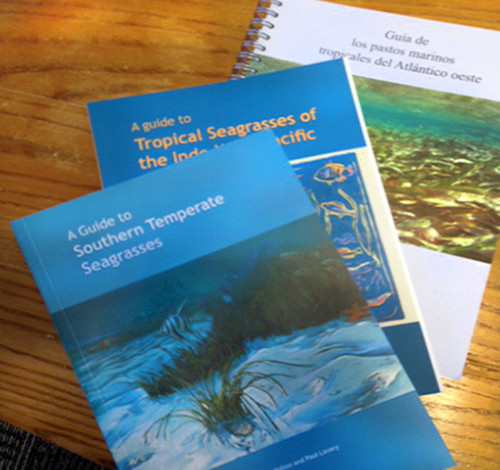"Seagrasses of the World" revisited: "A Guide to Southern Temperate Seagrasses" published
Bill Dennison ·Seagrass science was largely influenced by the seminal book "Seagrass of the World", written by Cornelis den Hartog in 1970. Professor den Hartog is a spritely Dutch botanist, now in his 80s, who also was the founding editor of the journal Aquatic Botany in 1975. This 270 pp. book was published by North-Holland Publishing Co. but was already out of print when I started my Masters degree program in 1978. Along with many of my cohort and succeeding seagrass researchers, I resorted to photocopying the entire book. den Hartog's book provided the taxonomic and ecological descriptions of the known seagrass species in the world, species distribution maps, and drawings of the vegetative and reproductive morphologies. Since the publication of "Seagrasses of the World", there has been an explosion of seagrass scientific literature and several seagrass books have focused on the physiology, morphology and ecology of seagrasses. Yet, no one has replaced den Hartog's classic book, even though new seagrass species have been discovered, molecular biology has elucidated evolutionary and genetic relationships, and our understanding of seagrasses has drastically increased.

What is happening through the sequential publication of different regional books, is the revision of "Seagrasses of the World" stepwise. The first of these regional books was "A Guide to Tropical Seagrasses of the Indo-West Pacific", written by Michelle Waycott, Kathryn McMahon, Jane Mellors, Ainsley Calladine and Diana Kleine. This beautifully illustrated 72 pp. book was published by James Cook University in 2004. The second regional book was "A Guide to the Tropical Seagrasses of the Western Atlantic", written by Brigitta I. van Tussenbroek, M. Guadalupe Barba Santos, J. Gonzalo Ricardo Wong, Jent Kor Eli's van Dijk and Michelle Waycott. This 80 pp. book, also beautifully illustrated, uses both English and Spanish, was published in 2010 by the Universidad Nacional Autonoma de Mexico. The third and most recent installment in this series of regional seagrass books is "A Guide to Southern Temperate Seagrasses", written by Michelle Waycott, Kathryn McMahon and Paul Lavery was released in 2014. This 108 pp. book is also beautifully illustrated and was published by CSIRO Press.
"A Guide to Southern Temperate Seagrasses" describes the different temperate seagrasses using high quality underwater photographs, distribution maps, conceptual diagrams and absolutely stunning colorful drawings of each species. The book includes succinct descriptions of the different seagrass plant families and provides user friendly keys to the different species. The species descriptions are informed by the latest genetic evidence, a far better way to classify species and relatedness than leaf tip morphology or other arbitrary characteristics. "A Guide to Southern Temperate" uses an interesting artistic technique of having translucent paper to showcase beautiful seagrass drawings.
Taken together, these three regional seagrass books encompass about three quarters of the globe. What will be needed to complete a global revision will be "A Guide to Northern Temperate Seagrasses", focusing on the various Zostera and Phyllospadix species of the North Atlantic and Pacific Oceans and the complement of Mediterranean Sea seagrasses. Once this final book is produced, den Hartog's "Seagrasses of the World" will have been completely revised, on the order of a half century after its publication.
The common link in the three regional seagrass books has been Michelle Waycott. Michelle is an evolutionary biologist who uses a variety of molecular techniques to investigate seagrasses. She is from Western Australia, adjacent to the extensive and biodiverse 'Great Barrier Reef of Seagrasses' that extends from Shark Bay to the Great Australian Bight. Michelle studied the southern temperate seagrasses during her undergraduate and graduate studies at the University of Western Australia. Michelle was a postdoctoral fellow at the Smithsonian Tropical Research Institute in Panama adjacent to the Caribbean Sea, and then moved to James Cook University adjacent to the extensive and biodiverse 'Great Barrier Reef of Corals' that extends from Torres Straits to Fraser Island. Thus, Michelle has had direct personal and professional experiences that have given her the opportunity to learn about the seagrasses in these diverse regions. Currently, Michelle is the HBS Wormersley Professor of Plant Systematics at the University of Adelaide and the Chief Botanist at the South Australia Herbarium and spends considerable time at the University of Virginia as well.
The difficulty in obtaining copies of "Seagrasses of the World", "A Guide to Tropical Seagrasses of the Indo-West Pacific", or "A Guide to the Tropical Seagrasses of the Western Atlantic" means that I highly recommend anyone interested in seagrasses to obtain a copy through CSIRO Press of this new book "A Guide to Southern Temperate Seagrasses" before it too goes out of print or becomes difficult to obtain.
My dream would be to have this fourth and final regional seagrass book completed and then all four regional books combined into a single eBook or print copy that would be readily available globally and permanently. Seagrass research would greatly benefit from having a single, definitive guide to the species of these beautiful underwater flowering plants.
About the author
Bill Dennison

Dr. Bill Dennison is a Professor of Marine Science and Vice President for Science Application at the University of Maryland Center for Environmental Science.

